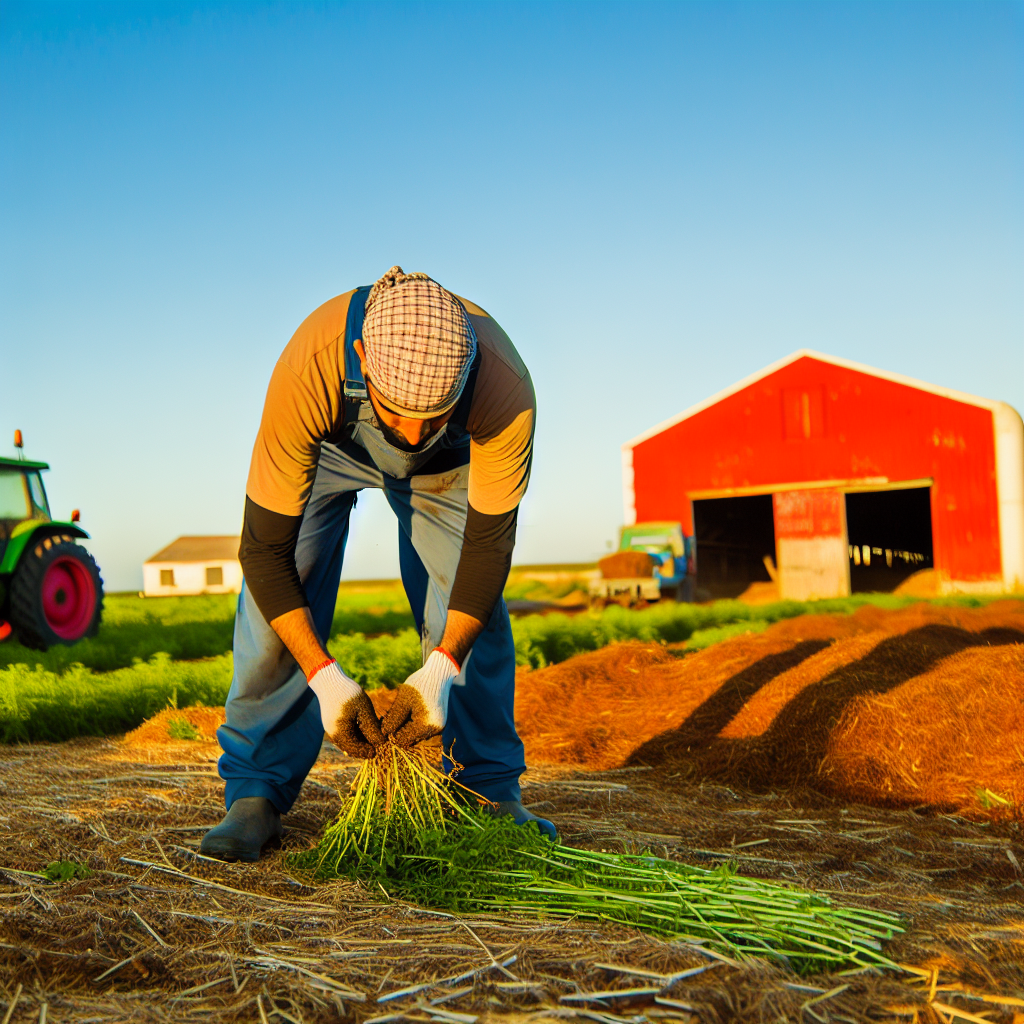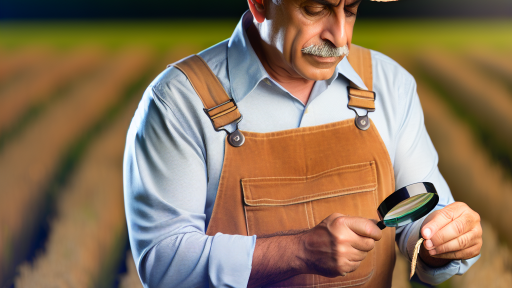Introduction to Mulching and Its Importance in Agriculture
Mulching plays a crucial role in sustainable agriculture.
It involves covering soil surfaces with organic or inorganic materials.
This practice offers multiple advantages for crop production.
Farmers increasingly recognize the benefits of mulching.
The technique enhances soil health and boosts productivity.
Soyl Moisture Retention
One significant advantage of mulching is moisture retention.
Mulch acts as a barrier to evaporation.
This keeps the soil moist for longer periods.
Consequently, plants can access water more efficiently.
As a result, crop yields often improve during dry spells.
Weed Suppression
Another important benefit is that mulching suppresses weeds.
By covering the soil, mulch blocks sunlight from reaching weed seeds.
This reduces weed germination and growth significantly.
Consequently, farmers spend less time and resources on weed management.
Overall, healthier crops emerge with less competition from weeds.
Transform Your Agribusiness
Unlock your farm's potential with expert advice tailored to your needs. Get actionable steps that drive real results.
Get StartedSoyl Temperature Regulation
Mulching also helps regulate soil temperature.
It insulates the soil against temperature extremes.
This creates a more stable environment for root development.
Consequently, plants withstand heat and cold more effectively.
The result is enhanced growth rates and increased productivity.
Organic Matter Addition
Organic mulches contribute valuable nutrients to the soil.
As they decompose, they enrich the soil with organic matter.
This improves soil structure and enhances nutrient availability.
Additionally, beneficial microorganisms thrive in this environment.
Thus, mulching fosters a vibrant soil ecosystem.
Reduced Soil Erosion
Finally, mulching reduces soil erosion.
The protective layer shields soil from wind and water erosion.
It helps maintain soil integrity and prevents nutrient loss.
As a result, sustainable farming practices are promoted.
This contributes to long-term agricultural viability.
Types of Mulching Techniques
Organic Mulching Techniques
Organic mulching involves using natural materials.
These materials include leaves, straw, and grass clippings.
Organic mulch improves soil structure over time.
Additionally, it enhances soil fertility as it decomposes.
Farmers often use wood chips for long-lasting coverage.
Moreover, organic mulching retains moisture effectively.
This technique also suppresses weed growth naturally.
It attracts beneficial organisms like earthworms.
Examples of organic mulch include sawdust and compost.
Showcase Your Farming Business
Publish your professional farming services profile on our blog for a one-time fee of $200 and reach a dedicated audience of farmers and agribusiness owners.
Publish Your ProfileInorganic Mulching Techniques
Inorganic mulching uses synthetic materials.
Common options include plastic sheeting and rubber mulch.
Plastic mulch aids in soil temperature regulation.
It helps retain moisture in the soil effectively.
Rubber mulch is durable and can last for years.
This type of mulch does not decompose like organic options.
Besides, inorganic mulch prevents soil erosion.
However, it does not improve soil health over time.
Farmers must weigh the benefits and drawbacks of each type.
Selecting the Right Mulch Material for Your Crops
Understanding Mulch Types
Different types of mulch serve varying purposes in agriculture.
Organic mulches include materials such as straw, grass clippings, and wood chips.
Inorganic mulches, like plastic or rubber, offer distinct benefits as well.
Choosing the appropriate mulch type can heavily impact productivity.
Evaluating Soil Types
Your soil type plays a crucial role in mulch selection.
For sandy soils, organic mulches can improve moisture retention.
Conversely, clay soils may benefit from inorganic options to prevent compaction.
Additionally, consider the pH levels of your soil.
Assessing Crop Needs
Different crops have unique requirements for mulch materials.
Vegetables often thrive with organic mulches that decompose into nutrients.
Fruits may require specific protection against pests and weeds.
Evaluate the growth stage of your crops when selecting mulch.
Considering Local Climate
Your local climate significantly affects mulch performance.
In hot regions, dark-colored mulches can help retain soil moisture.
Conversely, lighter-colored mulches reflect sunlight and keep soil cooler.
Regular climate changes can also influence your mulch choice.
Cost and Availability
Evaluate the cost of mulch materials before making a decision.
Consider sourcing locally to reduce transportation expenses.
Investigate the availability of preferred mulch materials in your area.
Always budget for both initial purchases and maintenance costs.
Environmental Impact
Be aware of the environmental implications of your mulch choices.
Organic mulches contribute positively by enriching soil health.
Inorganic mulches might require sustainable recycling practices.
Always aim to make eco-friendly selections that support biodiversity.
See Related Content: Training Farmers on Effective Post-Harvest Techniques
Best Practices for Applying Mulch to Enhance Soil Health
Understanding the Benefits of Mulching
Mulching significantly improves soil moisture retention.
It also reduces soil temperature fluctuations.
Furthermore, mulch helps suppress weed growth effectively.
In addition, it promotes healthy microbial activity in the soil.
Selecting the Right Mulch Material
Choose organic mulches like wood chips, straw, or grass clippings.
These materials break down and enrich the soil over time.
Showcase Your Farming Business
Publish your professional farming services profile on our blog for a one-time fee of $200 and reach a dedicated audience of farmers and agribusiness owners.
Publish Your ProfileAlternatively, consider inorganic options such as gravel or landscape fabric.
These options can provide long-lasting weed suppression.
Proper Application Techniques
Begin by preparing the soil before applying any mulch.
Remove existing weeds and debris to ensure a clean surface.
Then, spread mulch evenly to a depth of 2 to 4 inches.
Be careful not to pile mulch against plant stems or tree trunks.
Timing Your Mulching Efforts
Apply mulch after the soil has warmed in spring.
This timing maximizes benefits for your crops.
Alternatively, consider late fall applications to protect plants over winter.
This method prevents freeze-thaw cycles that can damage roots.
Monitoring and Maintenance
Regularly check mulch levels to ensure adequate coverage.
Add more mulch as needed to maintain thickness.
Additionally, remove any weeds that may surface through the mulch.
Ultimately, this care will enhance soil health in your garden or farm.
See Related Content: IoT Sensors Transforming Crop Analytics Today
Impact of Mulching on Weed Suppression and Soil Moisture Retention
Understanding Weed Suppression
Mulching creates a barrier that limits weed growth effectively.
It blocks sunlight, preventing weed seeds from germinating.
Additionally, mulch can smother existing weeds, limiting their resource access.
Organic mulches decompose over time, enhancing soil health.
Such decomposition enriches soil nutrients, aiding crop growth further.
Moreover, different mulch types impact weed suppression levels.
- S straw and hay provide effective cover and improve soil texture.
- Bark mulch serves as an aesthetic option while suppressing weeds.
- Rubber mulch is durable, though it may not enrich soil.
Enhancing Soil Moisture Retention
Mulching plays a crucial role in retaining soil moisture.
It reduces evaporation rates from the soil’s surface significantly.
This preservation of moisture is vital during dry spells.
Organic mulches, like wood chips, help regulate soil temperature.
Cooler soil temperatures promote healthier root systems.
Furthermore, mulched soil requires less frequent watering.
Consequently, farmers save on water resources while boosting productivity.
Implementing mulching techniques can lead to sustainable farming practices.
- Choose appropriate mulch materials based on available resources.
- Ensure proper application thickness for maximum benefits.
- Regularly monitor mulched areas for weeds or degradation.
You Might Also Like: Aquaponics Water Management Tips

Using Mulch to Regulate Soil Temperature and Promote Root Development
The Role of Mulch in Temperature Regulation
Mulch serves as an insulator for soil temperatures.
This regulation helps prevent extreme temperature fluctuations.
As a result, plants experience less stress during temperature changes.
Additionally, mulch retains moisture, reducing the need for frequent irrigation.
This moisture retention further supports consistent soil temperatures.
Promoting Root Development with Mulch
Healthy roots contribute to overall plant stability and growth.
Mulch provides a protective layer around plant bases.
This layer shields roots from harsh weather conditions.
Furthermore, it encourages deeper root growth by providing a stable environment.
With softer soil beneath the mulch, roots can expand more easily.
Showcase Your Farming Business
Publish your professional farming services profile on our blog for a one-time fee of $200 and reach a dedicated audience of farmers and agribusiness owners.
Publish Your ProfileTypes of Mulch for Improved Crop Productivity
Various types of mulch can be utilized for optimal results.
- Organic mulches include straw, bark, and wood chips.
- Inorganic options comprise plastic and gravel mulches.
Organic mulches break down over time, enhancing soil fertility.
In contrast, inorganic mulches are durable and suppress weeds effectively.
Best Practices for Applying Mulch
To maximize benefits, apply mulch correctly.
- Ensure an even layer of 2 to 4 inches deep.
- Avoid piling mulch directly against plant stems.
Regularly check mulch levels and replenish as needed.
This practice maintains effective temperature and moisture management.
Delve into the Subject: Cover Crops: Enhancing Biodiversity on Your Farm
Mulching Techniques for Different Crop Types
Vegetables
Mulching enhances vegetable growth by suppressing weeds.
This technique helps retain soil moisture effectively.
Organic mulches like straw and grass clippings work well.
These materials decompose, enriching the soil over time.
For heat-loving vegetables, consider black plastic mulch.
It raises soil temperature and encourages rapid growth.
Ensure the mulch layer is consistent for optimal results.
Fruits
Fruit crops benefit immensely from proper mulching techniques.
Wood chips and shredded leaves provide effective coverage.
This approach helps control soil temperature and moisture.
Additionally, mulch protects fruits from soil-borne diseases.
Consider using straw mulch for berry plants, like strawberries.
It prevents berries from contacting the soil directly.
Moreover, adjust the type of mulch based on fruit varieties.
Grains
Grain crops can thrive with strategic mulching practices.
Using cover crops before planting helps build organic matter.
Then, mulch can maintain soil fertility and suppress weeds.
Employing straw or composted materials enhances nutrient levels.
Properly applied mulch reduces competition from weeds.
As a result, grains can access necessary resources more easily.
Finally, choose the right mulch thickness for effective coverage.
Case Studies: Successful Implementation of Mulching in Various Agricultural Settings
Introduction to Case Studies
Several agricultural projects illustrate successful mulching techniques.
These case studies provide valuable insights into different settings.
They showcase the effectiveness of mulching in boosting productivity.
Case Study: Organic Vegetable Farm in California
Sunny Acres is a prominent organic vegetable farm in California.
The farm adopted straw mulching for its crops.
This technique significantly reduced weed growth.
As a result, the crops maintained higher moisture levels.
The location observed a 30% increase in overall yield within a year.
Moreover, the farm reported improved soil health over time.
Case Study: Wheat Production in Australia
Green Fields is a large-scale wheat farm located in Australia.
This farm implemented cover cropping followed by mulching.
This approach conserved soil moisture during dry seasons.
Showcase Your Farming Business
Publish your professional farming services profile on our blog for a one-time fee of $200 and reach a dedicated audience of farmers and agribusiness owners.
Publish Your ProfileThe yield improved by nearly 25% compared to previous years.
Additionally, applying organic mulch enhanced soil nutrient levels.
Case Study: Fruit Orchard in Spain
La Frutera is a family-owned fruit orchard in Spain.
They used black plastic mulch for berry production.
This method increased soil temperature, promoting growth.
The orchard also reported fewer pests due to reduced humidity.
Consequently, they enjoyed a 40% increase in berry harvest.
Case Study: Rice Paddies in Vietnam
The Mekong Delta is known for its extensive rice paddies.
Farmers began using rice straw as a biodegradable mulch.
This practice improved irrigation efficiency throughout the paddies.
Farmers noted enhanced crop resilience during wet seasons.
In turn, the region saw a rise in overall rice production.
Key Takeaways from the Case Studies
Each case illustrates different benefits of mulching techniques.
Improved soil health is a common theme across all locations.
Furthermore, increased moisture retention was emphasized.
Ultimately, lower weed competition led to higher yields.
These case studies encourage broader adoption of mulching in agriculture.
Additional Resources
NRCS Climate-Smart Mitigation Activities | Natural Resources …
Oregon State and partners will receive $50 million grant to develop …




